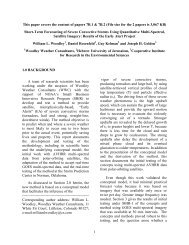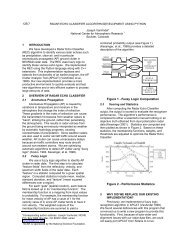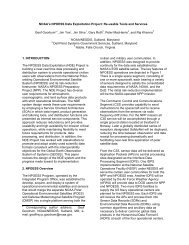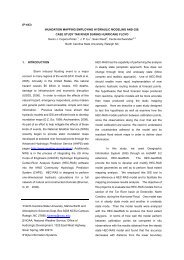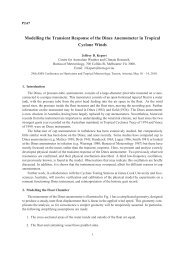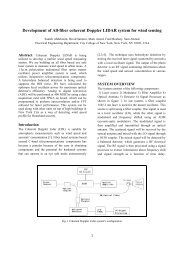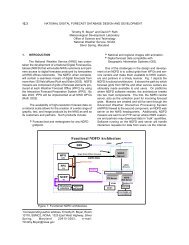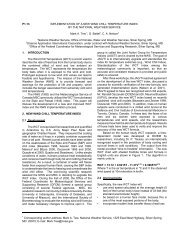Extended Abstract
Extended Abstract
Extended Abstract
Create successful ePaper yourself
Turn your PDF publications into a flip-book with our unique Google optimized e-Paper software.
P2.25 MOISTURE CORRESPONDENCE BETWEEN LOWER AND UPPER TROPOSPHERE OVER<br />
OCEANS USING AIRS OBSERVATIONS<br />
Hengchun Ye*<br />
C alifornia State U niversity, Los A ngeles, C A<br />
E . J. F etzer, S . G ranger, S .-Y . L ee, E . T . O lsen , B . H . L am b rid gtsen and L . C h en<br />
Jet P ropulsion Laboratory, C alifornia Institute of Technology, P asadena, C A.<br />
<strong>Abstract</strong><br />
This study uses AIRS level 3 moisture profile data to reveal geographical correspondences of<br />
atmospheric moisture content between lower and upper troposphere. The daily gridded AIRs<br />
atmospheric specific humidity over world oceans between 50ºS to 50ºN are used to derive threeday<br />
average vertical integrated moisture content for the two air columns: 1000mb-700mb and<br />
700mb-500mb for the available three years time period. Then singular value decomposition<br />
analysis (SVD) is performed to identify the teleconnections among grids between these two<br />
atmospheric layers. In addition, the time series of the resulting major SVD patterns are analyzed<br />
to reveal the dominant mode of temporal variations ranging from weekly to interannual time<br />
scales. Results suggest that there is a good agreement in moisture variations between lower and<br />
upper troposphere over middle-latitude and tropical oceans in general. Exceptions are found in<br />
small areas near a landmass where moisture profile may be different from the rest of the majority<br />
oceans.<br />
1. INTRODUCTION<br />
T h e A tm osp h eric I n fra red S ou n d er (A I R S )<br />
mounted on Aqua spacecraft measures vertical<br />
profiles of air temperature and humidity using both<br />
microwaves and infrared irradiances (P agano et<br />
al. 2003; L am brigtsen and L ee 2003; S u sskind et<br />
al. 2003; Autmann et al. 2003). The AIR S’ level III<br />
data that provide gridded values of 1° la titu d e b y<br />
1 ° longitude for the highest tem poral resolution of<br />
twice p er d a y b eca m e a va ila b le recently (G ra n ger<br />
et al., 2005). This level III data were derived from<br />
th e L evel I I V ersion 4 . 0 A I R S retrieva l a lgorith m<br />
(F etzer et al. 2005; Ye et al. 2005). This gridded<br />
level III data set will be very valuable for the<br />
clim ate research com m u nity.<br />
Corresponding author’s address: Hengchun<br />
Ye, Department of Geography and Urban<br />
Analysis, California State University, Los<br />
Angeles, 1515 State University Drive, Lo<br />
Angeles, CA 90032-8222; e-mail:<br />
hye2@calstatela.edu<br />
This study uses AIR S moisture profile data<br />
to revea l geogra p h ica l corresp on d en ces of<br />
a tm os p h e ric m ois tu re con te n t b e twe e n th e lowe r<br />
and upper troposphere.<br />
2. METHODOLOGY<br />
The daily gridded AIRS atmospheric<br />
specific hum id ity over world oceans between 50ºS<br />
to 5 0ºN are used to derive three-day averages of<br />
ve rtica l in te gra te d m ois tu re con te n t for th e two a ir<br />
columns: 1000mb-500mb (1000mb, 925mb,<br />
850mb, 700mb, 600mb, 500mb) and 500mb-<br />
100mb (400mb, 300mb, 250mb,<br />
200m b,1 50m b,1 00m b) for the six m onths of<br />
January to June, 2005. The vertical integration of<br />
wa te r va p or is b a s e d on th e followin g e qu a tion :<br />
w =<br />
∫<br />
p1<br />
p2q i<br />
*∆p i<br />
g<br />
Then singular value decomposition<br />
a n a ly s is ( S V D ) is p e rform e d to id e n tify th e<br />
teleconnections among grids between these two<br />
atmospheric layers. Thus the two fields analyzed<br />
in SVD are the m oisture field below 500m b and<br />
the m oisture field above 500m b. The tim e series
of th e re s u ltin g m a jor S V D p a tte rn s a re u s e d to<br />
reveal the dominant mode of temporal variations<br />
ra n gin g from d a ily to s e a s on a l tim e s ca le s .<br />
3. RESULTS<br />
phenom enon can be seen from daily m oisture<br />
changes. W hile over equatorial regions of eastern<br />
P acific between 1 50W -1 20W , u p p er trop osp heric<br />
m oisture seem s to have a stronger seasonal<br />
variation.<br />
S ix m a jor p a ttern s p rod u ced b y S V D a re<br />
analyzed. They explain about 46.8% of total<br />
va ria n ce of th e two m ois tu re fie ld s b e low a n d<br />
above 500m b.<br />
The tim e series of pattern 1 shows a<br />
stron g season a l p a ttern of va ria tion : th e va lu e<br />
p ea ks in early F eb ru a ry a n d d ecreases gra d u a lly<br />
for the rem aining 5 m onths (F igure 1 ). The P C 1<br />
for both below and above 500mb match<br />
closely.<br />
F igu re 1 . T im e series of P C 1 for b elow 500m b<br />
(B lue) and above 500m b (green).<br />
This suggests that abundant moisture over<br />
the southern hemispheric tropical ocean is<br />
decreasing while these over the northern<br />
h em isp h ere it is in creasin g startin g in early<br />
February both below and above 500mb (Figure 2<br />
and F igure 3). The correspondence between<br />
b e low a n d a b ove 5 00m b for th is s e a s on a l p a tte rn<br />
is very close except for a few areas. O ne of the<br />
m ajor differences lies over 20°S in the western<br />
S ou th P acific O cean, extend ing from east coast of<br />
A u s tra lia to a b ou t 1 5 0W . I n th is re gion , th e<br />
m oisture is m ore abund ant in the lower<br />
trop os p h e re th a n th e u p p e r, th u s m ore s ign ifica n t<br />
s e a s on a l va ria tion s of m ois tu re e xis t in th e lowe r<br />
trop osp h ere. A sim ila r p a ttern to th is (m irror<br />
im age) is evident in the N orth P acific O cean where<br />
the lower atm ospheric m oisture also seem s to<br />
have stronger seasonal variations. This m ay be<br />
re la te d to th e fa ct th a t m ois tu re is d is ch a rge d in to<br />
th e s e a re a s con s ta n tly th rou gh ou t th e y e a r from<br />
land areas over upper troposphere. This<br />
F igu re 3 . E O F of P C 1 on m oistu re ab ove 500m b .<br />
P attern 2 shows intraseasonal variations<br />
overlaid with a seasonal variation that peaked in<br />
ea rly A p ril (F igu re 4 ). O n d a ily sca les, P C 2 for<br />
lower trop osp heric (blu e) m oistu re has slightly<br />
different values com pared to the upper<br />
troposphere
(green).<br />
F igu re 4 . T im e series of P C 2<br />
The m ajor activities described by this pattern are<br />
over the eastern equatorial P acific, the equatorial<br />
Atlantic ocean, and the southern Indian O cean<br />
( F igu re 5 a n d F igu re 6 ) . V a ria tion of th is p a tte rn<br />
seems to be strong over the lower troposphere in<br />
m ost areas. H owever, in the area over the<br />
n orth ern coa st of A u stra lia , a n d coa st of sou th ern<br />
A frica , th e va ria tion s seem to b e m ore n oticea b le<br />
on u p p er<br />
troposphere.<br />
F igu re 6. E O F of P C 2 for m oistu re above 500m b.<br />
P a tte rn th re e s h ows a n in tra s e a s on a l<br />
va ria tion of a b ou t 5 0 d a y s with th e s tron ge r cy cle<br />
occu rring over F ebru ary and M arch (F igu re<br />
7).<br />
F igu re 7 . T im e series of P C 3<br />
Figure 5. EOF of PC2 for moisture below 500mb.<br />
This pattern reveals sandwiched off-phase<br />
m ois tu re ch a n ge s ove r th e m id d le a n d trop ica l<br />
P acific O ceans. A ctivities seem to be of sim ilar<br />
stren gth s b etween lower a n d u p p er trop osp h ere,<br />
except over the western equatorial ocean where<br />
u p p er trop osp h ere h a s a stron ger va ria tion<br />
amplitude (Figure 8 and Figure 9).
Figure 8. EOF of PC4 for moisture field below<br />
500m b<br />
F igu re 1 0. T im e series of P C 5<br />
T h is p a tte rn d e s crib e s m ois tu re a ctivitie s<br />
over isolated centers almost all concentrated in<br />
the P acific and Indian oceans (F igure 1 1 and<br />
F igure 1 2). The southwest-to-northeast<br />
orientation of these centers m arks the influence of<br />
trade winds especially over the P acific tropical<br />
ocean.<br />
Figure 9. EOF of PC4 for moisture field above<br />
500m b<br />
P attern four shows seasonal variation at<br />
a b ou t 4 -m on th tim e s ca le with a p e a k in e a rly<br />
M a rch a n d la te J u n e . T h is p a tte rn s h ows m ore<br />
m oistu re va ria tion over th e u p p er trop osp h ere for<br />
certain areas (F igure 8 and F igure 9). Three<br />
m ajor centers are (1 ) over the eastern tropical<br />
P acific O cean and the western coast of South<br />
A m erica, (2) over the western Indian O cean with<br />
two op p os ite p h a s e s b e twe e n n orth e rn a n d<br />
equatorial areas, and (3) over the South Indian<br />
O ce a n off th e coa s t of n orth we s te rn A u s tra lia . I n<br />
m oisture fields below 500m b, there is an alm ost<br />
continuous area of active moisture variation from<br />
th e e qu a toria l I n d ia n O ce a n to th e ce n tra l P a cific<br />
O ce a n , wh ile th is is n ot th e ca s e for th e m ois tu re<br />
field s above 500m b.<br />
P attern five shows moisture variation at a<br />
tim e scale of 30 days. (F igure 1 0). The variation is<br />
s tron ge r d u rin g th e firs t th re e m on th th a n in la te r<br />
months.<br />
Figure 11. EOF of PC5 for moisture field below<br />
500mb
F igu re 1 2 . E O F of p a tte rn 5 for m ois tu re fie ld of<br />
above 500m b<br />
F igu re 1 4 . E O F of p a ttern six for m oistu re field<br />
below 500mb<br />
P a tte rn s ix s e e m s to s h ow a 1 0-d a y m ois tu re<br />
cycle overlaid on three m onthly variations (F igure<br />
13).<br />
F igu re 1 5 . E O F of p a ttern six for m oistu re field<br />
above 500m b<br />
F igu re 1 3 . T im e series of p attern six<br />
A ctivity ce n te rs of th is p a tte rn a ls o s h ow a<br />
s ou th we s t-to-n orth e a s t orie n ta tion . M os t<br />
interesting of these is a dry center over the<br />
western coast of South A m erica for below 500mb<br />
corre s p on d in g to a re la tive we t ce n te r a b ove<br />
500mb (Figure 14 and figure 15).<br />
4. CONCLUSIONS<br />
This study analyzed connections of<br />
m ois tu re con te n t b e twe e n th e lowe r a n d u p p e r<br />
troposphere over global middle-latitude and<br />
trop ica l oce a n s for th e tim e p e riod of 6 m on th in<br />
2 005 . I t is in te re s tin g to s e e th a t th e d om in a n t<br />
seasonal and intraseasonal variation patterns<br />
corresp ond well between lower and u p p er<br />
troposphere with stronger variability over the lower<br />
trop os p h e re . A s th e va ria n ce of p a tte rn<br />
decreases, poorer correspondence starts to show<br />
in som e areas upper troposphere m ay have larger<br />
variability than lower troposphere or even no<br />
a ctivity is fou n d in th e re .<br />
This study suggests that a universal<br />
m oisture profile over oceans is in general a good<br />
assu m p tion. E xcep tions occu r over certain<br />
geogra p h ica l region s n ea r to a la n d m a ss, wh ere<br />
m oisture profiles m ay be m od ified .
5. REFERENCES<br />
A u m ann, H . H ., M . T . C h ah in e, C . G au tier, M . D .<br />
G old berg, E . K alnay, L . M . M cM illin, H .<br />
R evercom b , P . W . R osen kranz, W . L . S m ith , D . H .<br />
Staelin, L. L. Strow and J. Susskind, 2003:<br />
A IR S /A M S U /H S B on th e A qu a m ission : d esign ,<br />
science objectives, d ata p rod ucts and p rocessing<br />
system, IEEE Trans. Geosci. And Remote<br />
Sensing, 41, 253-264.<br />
Fetzer, E . J., A. E ldering, E . F. Fishbein, T.<br />
H earty, W . F . Iron and B . K ah n , 2 005: V alid ation<br />
of A IR S /A M S U /H S B core p rod u cts for d ata<br />
release version 4.0, M arch 8, 2005, JP L D -31448,<br />
79 pages<br />
(h ttp ://d isc.gsfc.nasa.gov/A IR S /in d ex.sh m l/).<br />
Lambrigtsen, B . H .,, and S.-Y. Lee, 2003:<br />
C oalignment and synchronization of the AIR S<br />
instrum ent suite, IE E E Trans. G eosci, and R em ote<br />
Sensing, 41, 343-351.<br />
P agano, T . S . H . H . A u m ann, D . E . H agan and K .<br />
O veroye, 2003: P relaunch and in-flight radiom etric<br />
calibration of the A tm osp heric Infrared S ou nd er<br />
(AIRS), IEEE Trans. Geosci. and Remote<br />
Sensing, 41, 265-273.<br />
Granger, S., Leroy, S.S., M anning, E .M ., Fetzer,<br />
E .J., O liphant, R .B ., B raverman, A., Lee, S.Y.,<br />
L am brigtsen, B ., 2004: D evelop m ent of level 3<br />
(grid d ed ) p rod u cts for th e A tm osp h eric I n fra red<br />
Sounder (AIRS), In Proceedings of IGARSS 2004,<br />
20-24 September 2004, Anchorage Alaska<br />
Ye, H ., E . J. Fetzer, E . T. O lsen, A. E ldering, S.<br />
G ranger, L . C h en , B . H . L am b rigtsen , E . F ish en ,<br />
S.-Y. Lee, 2005: Structure of the lower<br />
atm osphere over the P acific O cean: inform ation<br />
gained from A IR S observations. N inth S ym posium<br />
on Integrated O bserving and A ssim ilation S ystem s<br />
for the Atmospherei, O ceans, and Land Surfaces<br />
(IO AS-AO LS), P 1 .4. American M eteorological<br />
Society.



